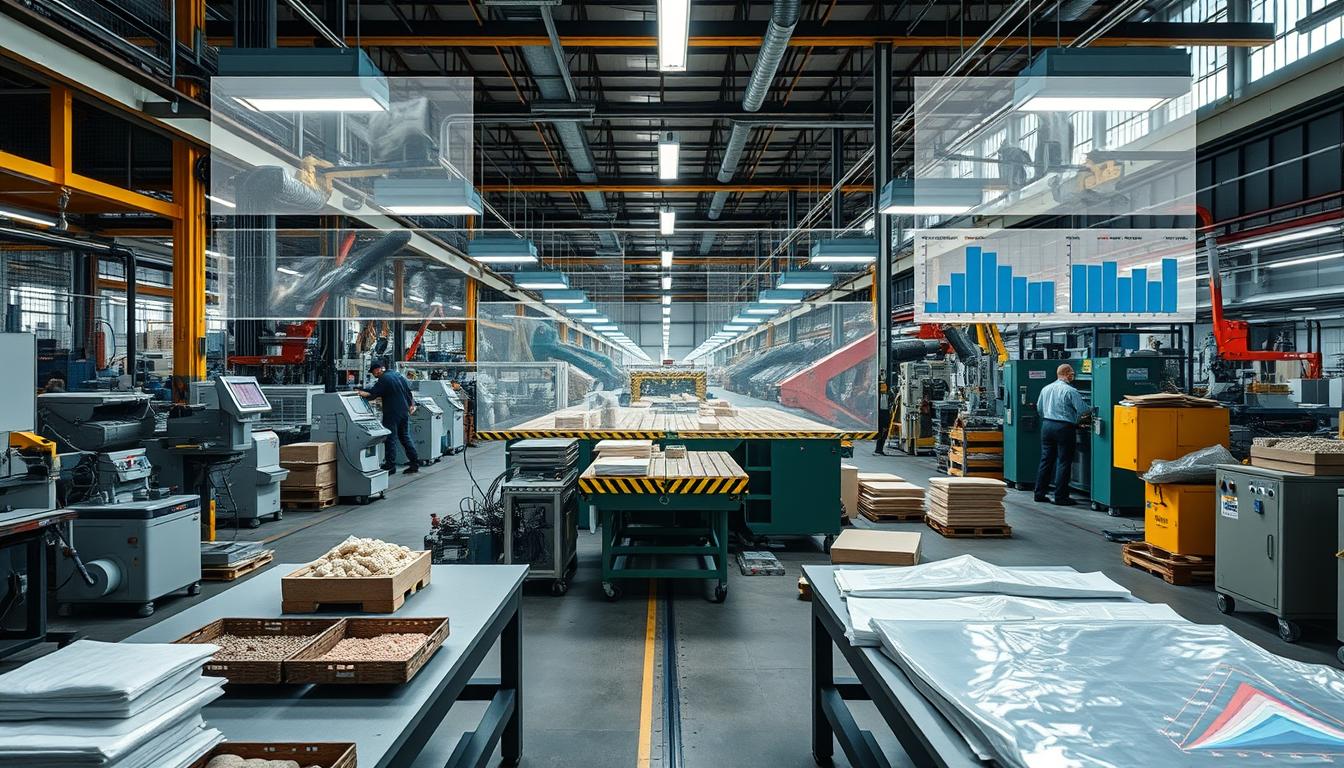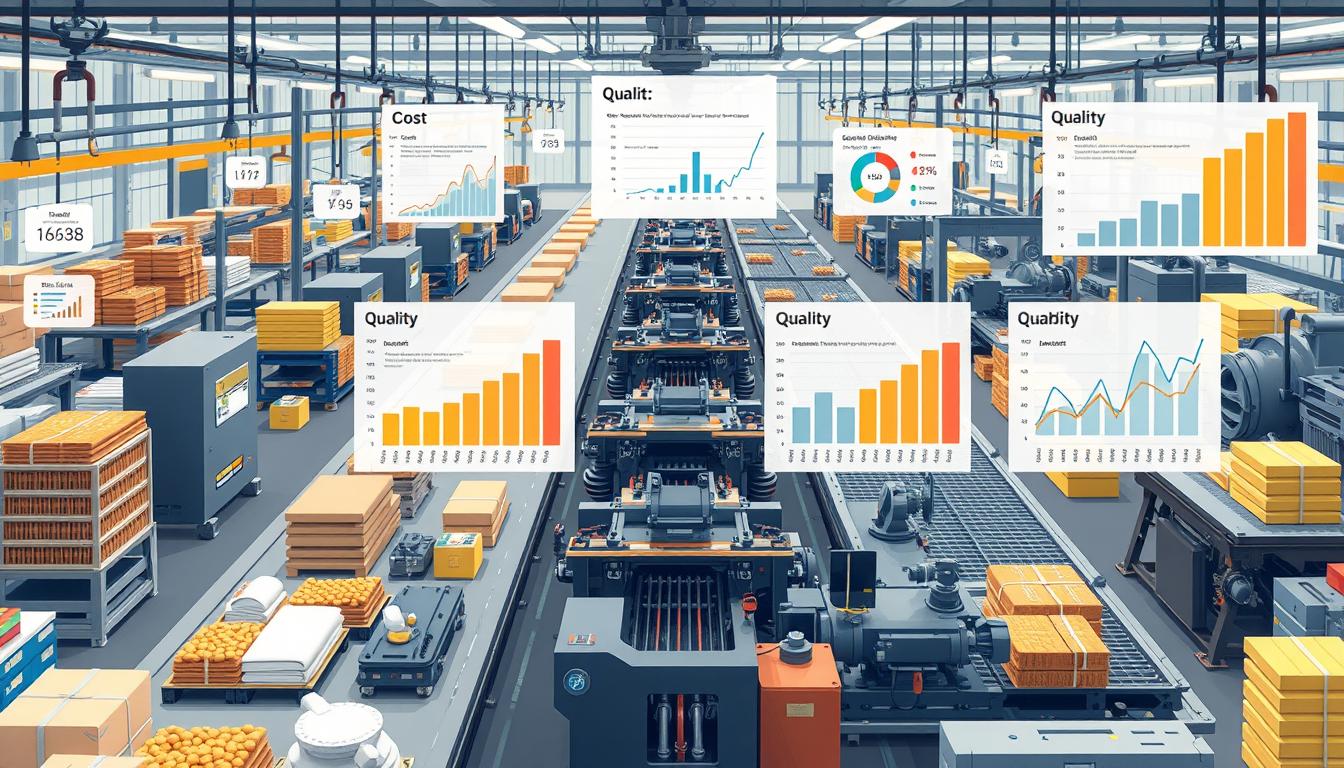Every project you start mixes hope, expectations, and real outcomes. In manufacturing, this mix is shown through production variance. Imagine feeling upset after investing in a work order, only to face unexpected costs. This situation is something many can relate to. Knowing the difference between expected and real costs is essential. It helps make manufacturing more efficient. By understanding variance analysis, you can improve operations. You also make better cost management choices. This knowledge turns challenges into chances for growth.
Key Takeaways
- Manufacturing variance highlights the difference between estimated costs and actual production expenses.
- Ongoing variance analysis requires consistent effort and time for meaningful insights.
- Accurate reporting and work order structures are crucial for generating effective variance reports.
- Enterprise resource planning (ERP) systems are essential for robust data collection and analysis.
- Addressing root causes of variances leads to better decision-making and process improvements.
What is Production Variance?
Production variance is key to spotting differences in expected and actual manufacturing costs. It’s vital for making sure your operations are efficient. Knowing about production variance helps keep things running smoothly.
Definition and Importance
Production variance is the gap between planned and actual production costs. It highlights where processes might be falling short. By spotting these gaps, companies can fix inefficiencies in labor and resources. It plays a big role in reducing costs and boosting efficiency in manufacturing.
Why Understanding Production Variance Matters
Understanding production variance is crucial for business decision-making. It helps manufacturers improve efficiency and control costs. With this knowledge, companies can grow and stay competitive in a fast-paced market. Understanding production variance allows companies to identify areas of inefficiency, such as excessive material waste or underutilized capacity, and make necessary adjustments to their processes. By analyzing the causes of production variance, businesses can also uncover opportunities for improvement and implement strategies to minimize fluctuations in output. Overall, having a comprehensive understanding of production variance is essential for maintaining a sustainable and profitable operation.
| Key Concept | Description |
|---|---|
| Production Variance | Difference between expected and actual production costs. |
| Importance of Variance Analysis | Identifies inefficiencies and reduces costs. |
| Manufacturing Cost Efficiency | Utilization of resources to minimize production costs. |
The Mechanics of Production Variance Analysis
Understanding how production variance analysis works is key for effective management in the manufacturing field. It helps spot differences and areas needing improvement. Gathering accurate data and using ERP systems are vital in this analysis.
Collecting Data for Improvement
Precise data collection methods are central to effective production variance analysis. It’s crucial to gather detailed info about material use, labor hours, and inefficiencies. This way, you can spot patterns and improve production. For example, if there’s a $3,000 material variance or a $4,800 labor variance, it’s a cue for further investigation. These clues help in crafting strategies to boost efficiency and performance.
The Role of ERP Systems in Data Collection
ERP systems are crucial for robust data collection in variance analysis. They gather info from different areas, automating data collection. This leads to accurate, up-to-date insights. For example, with a $1,600 unfavorable overhead variance, ERP systems help track and analyze these metrics. They not only help in reviewing past performance but also in planning for future efficiency gains.
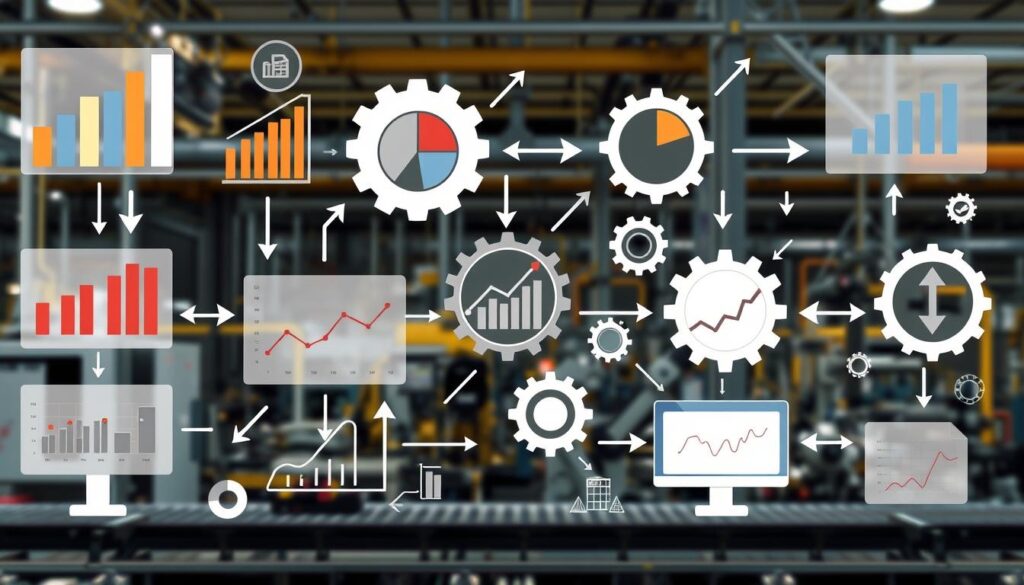
Interpreting the Manufacturing Variance Report
Understanding the manufacturing variance report is key to spotting budget and actual result differences. Analyzing variance report parts can help make wise choices and boost manufacturing.
Components of the Manufacturing Variance Report
The manufacturing variance report includes crucial elements. These are:
- Estimated Costs: Budget figures from past data and expected costs.
- Actual Costs: Real costs during production, showing financial status.
- Calculated Variances: The gap between estimated and actual costs, showing important deviations.
Understanding these parts helps focus on needed operational improvements. Regular analysis aids in controlling costs and raising profits.
Assessing Estimated vs. Actual Costs
It’s important to know the gap between estimated and actual costs for smart decisions. Variances highlight critical focus areas:
- Labor reporting errors show where to enhance efficiency.
- Material usage gaps suggest refining production methods.
- Knowing these variances offers insights for better procurement and logistics.
This knowledge is vital for maintaining your manufacturing operation’s financial well-being.
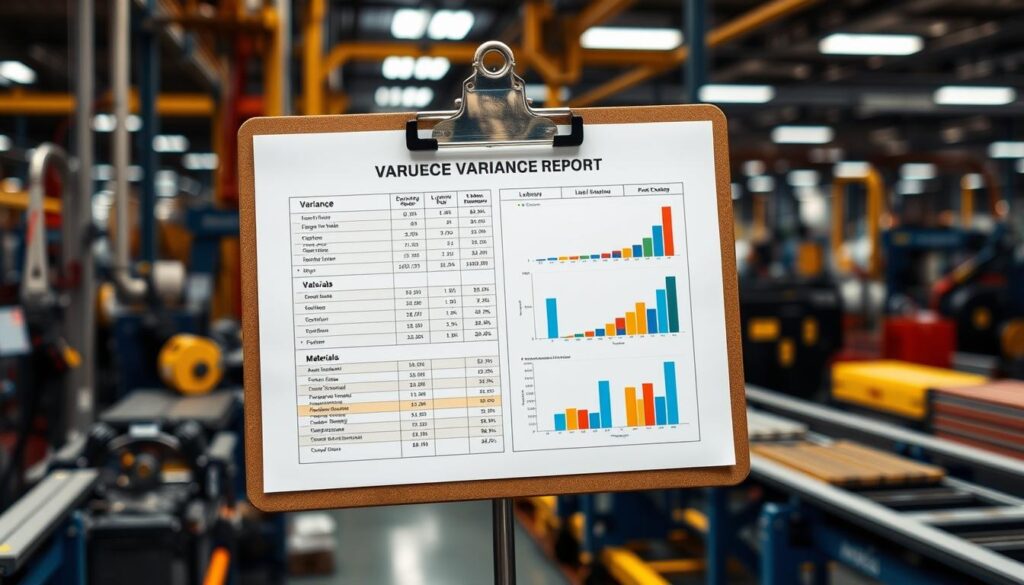
| Type of Variance | Description | Indication |
|---|---|---|
| Direct Material Variance | Difference between actual material costs and standard costs. | Cost efficiency or excess use issues. |
| Labor Variance | Difference between actual labor costs and standard costs. | Chance for better productivity or inefficiency. |
| Overhead Variance | Changes in manufacturing overhead costs. | Efficiency in controlling costs or production delays. |
Production Volume Variance Explained
Understanding production volume variance is key to keeping a manufacturing operation financially healthy. It checks how actual production matches up with what was planned, impacting profitability. Learning from production volume variance improves cost control and decision-making.
What is Production Volume Variance?
Production volume variance looks at the difference between actual and planned production, with a focus on overhead costs. It reveals how well resources are used. While fixed costs like rent stay the same, variable costs such as materials change with production levels.
Calculating Production Volume Variance
The formula to find volume variance is:
(actual units produced – budgeted production units) x budgeted overhead rate per unit
A positive variance means you produced more than expected, lowering the cost per unit. For example, producing more than planned might save $1,500, showing good financial management. It’s crucial for figuring out if making products at a certain volume is profitable.
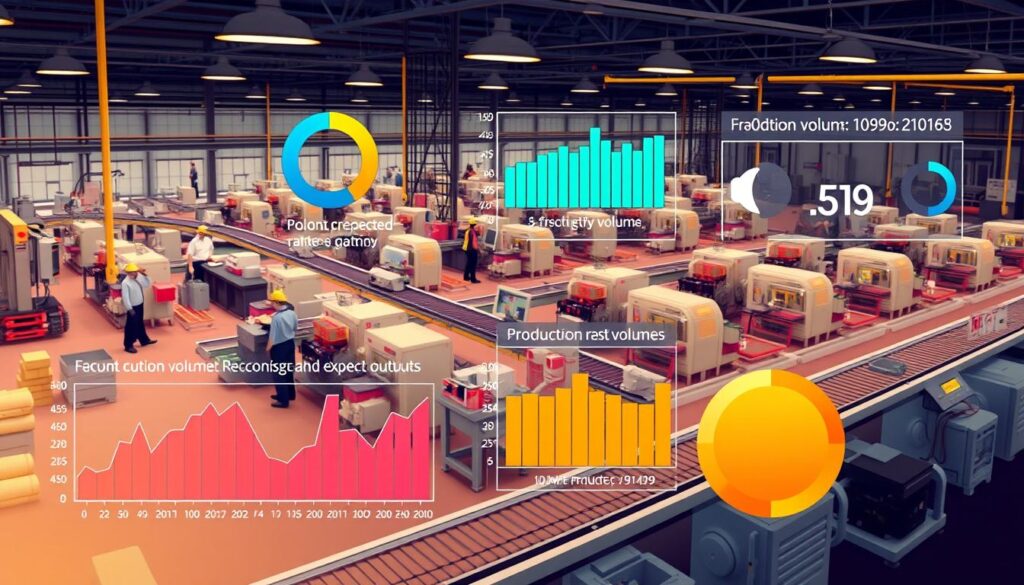
| Type of Cost | Description (per unit) |
Impact on Production Volume Variance |
|---|---|---|
| Fixed Costs | Constant expenses, e.g., rent | Remain unchanged regardless of volume |
| Variable Costs | Expenses that change, e.g., raw materials | Change with production levels |
Regularly checking production volume variance aids in improving operations and cost management. Using this metric can make your manufacturing process leaner and more profitable.
Factors Affecting Production Variance
Knowing what affects production variance is vital for any business focused on making products. It’s all about managing costs efficiently and keeping things running smoothly. Fixed costs don’t change, while variable costs do, depending on how much you’re producing. Both labor and materials also play big roles in how things add up at the end.
Fixed and Variable Costs in Production Variance
It’s very important to know the difference between fixed and variable costs. Fixed costs stay the same, no matter how much you produce. This is like the base cost of just having your operation ready to go. Variable costs, however, go up or down based on how much you’re making. These changes affect your budget. Knowing how these costs work together helps you find ways to better manage your money.
Labor and Material Reporting Impact
Accurate reports on labor and materials are key to understanding production variance. When things don’t add up right, it messes with your analysis. You need to keep track of how many hours people work and how much material you use. This makes sure your cost understanding is clear. Good reporting practices make your manufacturing variance reports more trustworthy. This leads to smarter choices in how to run things.
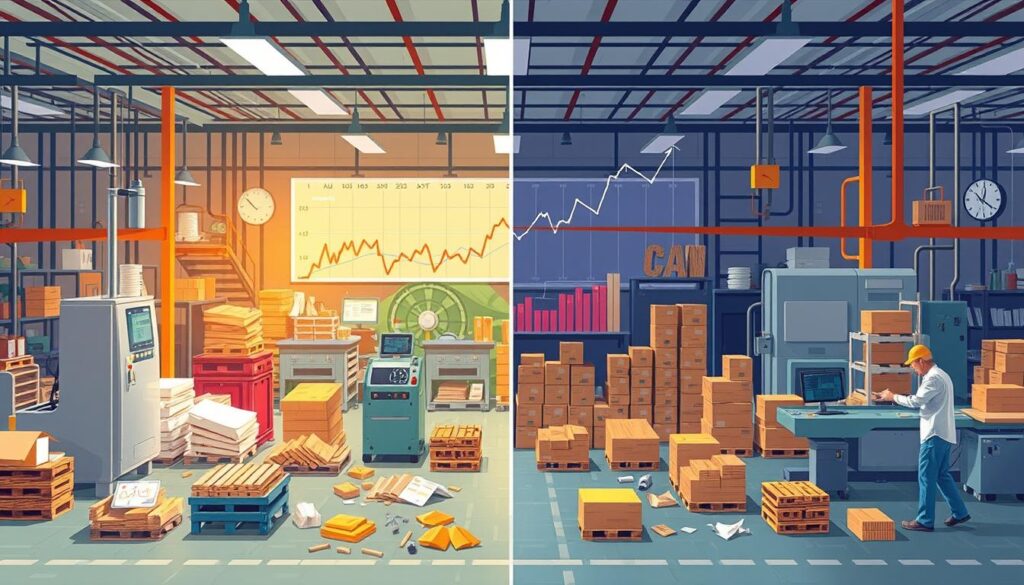
| Type of Variance | Causes | Reporting Impact |
|---|---|---|
| Material Usage Variance | Difference in actual and standard quantities | Affects cost control and resource allocation |
| Labor Usage Variance | Discrepancy in actual labor hours versus standard hours | Impacts payroll accuracy and productivity analysis |
| Production Price Variance | Variations in cost categories | Influences budgeting and expense forecasting |
| Transfer Variance | Shipping or receiving inventory from differing sites | Can complicate inventory management strategies |
Strategies to Reduce Production Variance
Reducing production variance is key to better manufacturing efficiency. This involves finding important areas to work on and making strong plans for improvement. By focusing on manufacturing weaknesses, you can make processes smoother and boost your profits.
Identifying Key Areas for Improvement
Begin by looking at production data to spot big differences that might show inefficiencies. Some main areas to check are:
- Quality of incoming materials
- Standardization of procedures
- Equipment maintenance and calibration
- Labor cost causes
Dealing with big inefficiencies can lead to better quality and lower costs. For example, using Six Sigma or control chart data can highlight common issues. Managing these can make processes more consistent.
Creating Action Plans for Variance Reduction
Base your plans for improvements on what the data tells you. Consider these steps:
- Set firm quality control for all materials that come in.
- Create standard procedures to boost efficiency.
- Keep equipment in good shape and properly set to avoid quality issues.
- Work with suppliers to find and fix sources of inconsistency.
This careful approach leads to small changes, making it easier for your team to hit goals without feeling swamped by big projects. Watch key performance indicators closely to see how well your actions work. By continuously tweaking your methods for lowering variance, you’ll make lasting enhancements in how things are made.
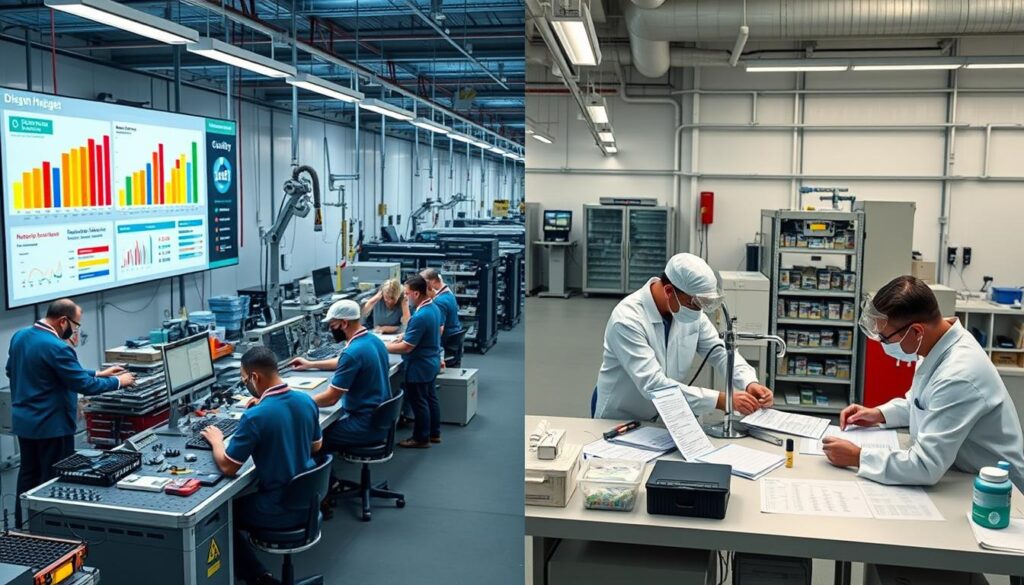
| Strategy | Benefits |
|---|---|
| Quality Control Measures | Minimized variance through better material checks. |
| Standard Operating Procedures | Better consistency and efficiency in making things. |
| Equipment Maintenance | Lesser product quality issues with reliable operations. |
| Supplier Collaboration | More reliable materials and less variability in making things. |
The Continuous Process of Managing Production Variance
Managing production variance is an ongoing journey. It needs regular monitoring and fine-tuning of production methods. Creating a strong framework for this process helps improve and ensure accountability in manufacturing.
Establishing a Cycle of Improvement
To manage production variance well, adopt a cycle of continuous improvement. Assess performance metrics, spot bottlenecks, and find solutions to these issues regularly. This will build a culture of accountability and link every action to the goals of managing production variance.
Focusing on Incremental Changes
Small steps can make a big impact. By making slight yet impactful modifications, you foster lasting innovations instead of drastic changes. These changes, based on data, lead to smarter decisions and boost operational efficiency.
As you make these adjustments, tracking growth through metrics is valuable, such as:
| Metric | Before Change | After Change | Variance |
|---|---|---|---|
| Average Downtime (hours) | 10 | 4 | -6 |
| Production Output (units/day) | 500 | 700 | +200 |
| Schedule Adherence (%) | 80 | 95 | +15 |
| Material Handling Time (minutes) | 30 | 20 | -10 |
| Assembly Time (minutes) | 45 | 35 | -10 |
| Quality Control Time (minutes) | 20 | 15 | -5 |
By focusing on small, manageable improvements, your organization can achieve consistent growth. This leads to more efficient and higher quality manufacturing processes.
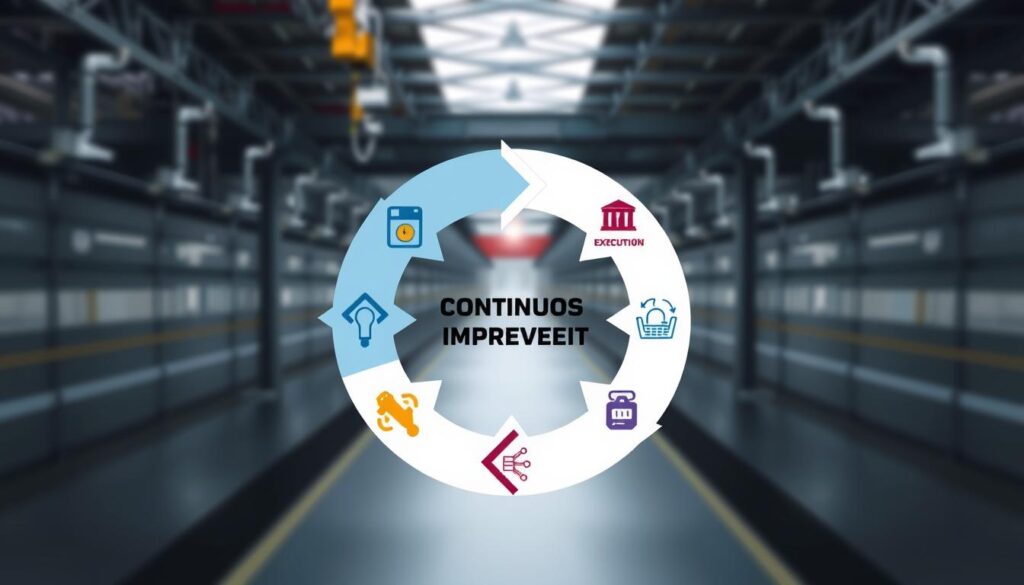
Conclusion
Getting a handle on production variance is key to doing well in manufacturing. A complete look at production variance shows the gaps between planned and real costs. It also shows why collecting and analyzing data well matters. For example, seeing a cost variance at -20% shows how important it is to keep an eye on projects to avoid spending too much.
By using advanced tools like ERP systems, making products can get a lot better. These tools help you organize and understand your data better. So, your work matches up with your financial goals. This leads to making more with less and earning more money.
Staying on top of and improving your processes means your manufacturing will succeed over time. Learning from variance analysis helps avoid problems and supports ongoing betterment. It makes your business ready to adapt quickly to new challenges and what customers want.
